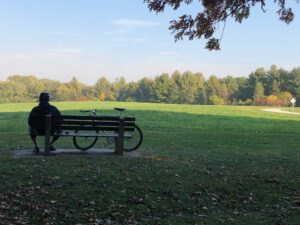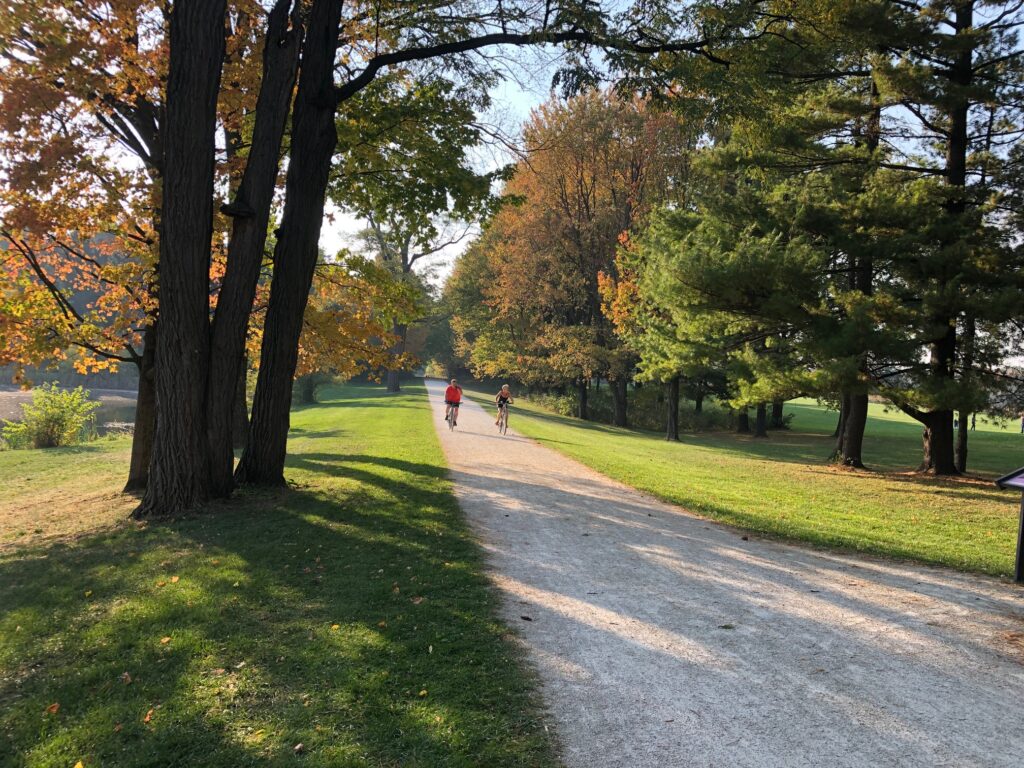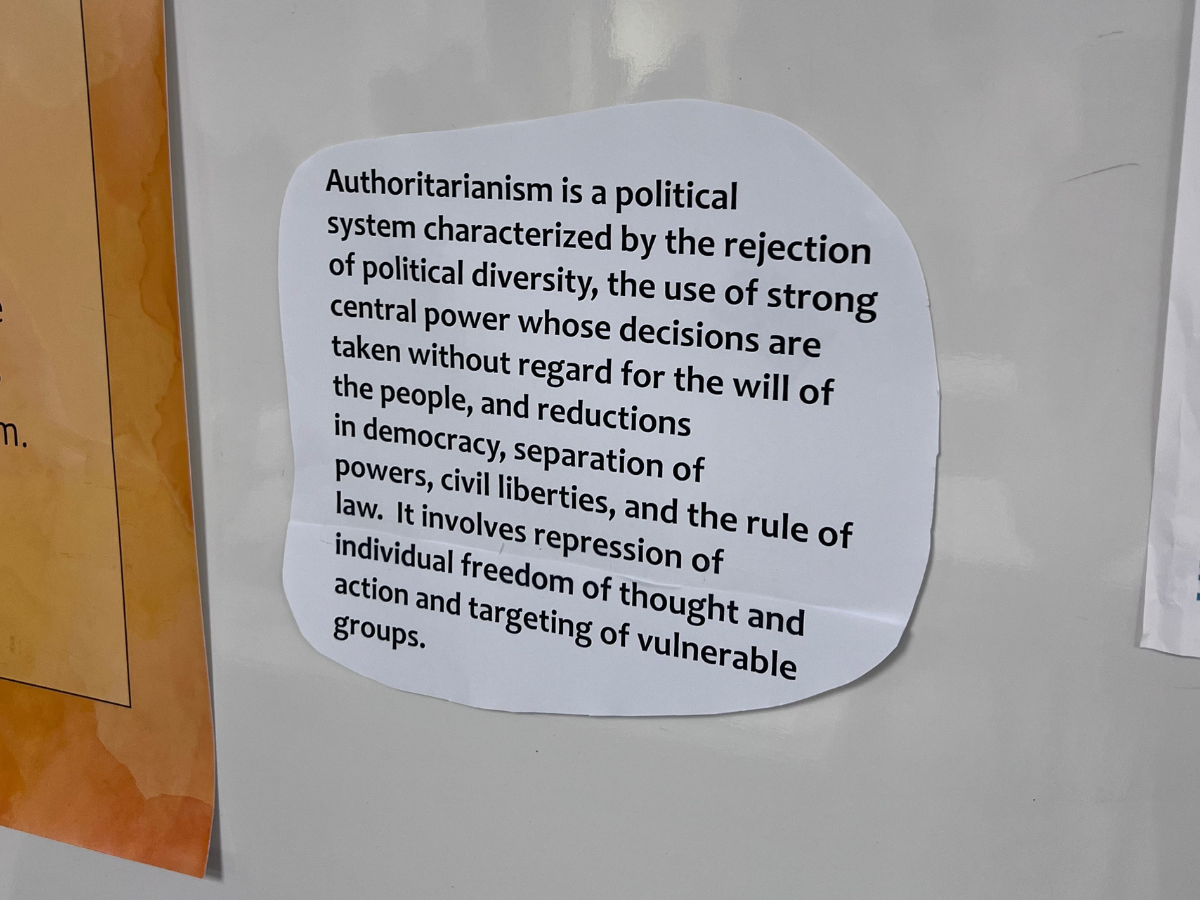Cyclists enjoy a fall ride on an offshoot of the Illinois Prairie Path. [Credit: Jennifer Taylor]
(WHEATON, Ill.) — The Illinois Prairie Path is always busy.
Developed from an abandoned railway, the 61-mile trail system located just west of Chicago includes five branches connecting 18 communities in three counties. It’s been a recreational staple for hikers, cyclists, and horseback riders for decades.
However, the trail took on a new life when the coronavirus hit this spring. A state-sanctioned “stay at home” order passed in March required people to keep themselves indoors with few exceptions. Streets went quiet as offices closed and employees worked from home. Schools shuttered. Business owners closed up shop, some for good, all in an effort to bend a curve of COVID-19 deaths.
However, as the lockdown dragged on, foot traffic on the trail surged. Board members of the Illinois Prairie Path, a nonprofit organization charged with overseeing the trail of the same name, polled users in mid-June and were surprised to discover a community under intense stress from an unrelenting contagion. They found the trail had shifted from being a source for physical health to something central to surviving the pandemic — a path to maintaining mental health.
Respondents to the poll, which The Click was allowed to review, described how they turned to the Prairie Path.
“It’s truly saved my sanity,” said a survey-taker who identified as a runner. According to another trail user, the path “has been a blessing to us at this time.”
For many, the Prairie Path became a lifeline.
THE PANDEMIC TAKES A TOLL
Erik Spande, one of the path’s most dedicated stewards, was one of the first to witness what was transpiring on the trail.
Spande is an environmental scientist who serves as president of the Illinois Prairie Path board. He’s also mayor of neighboring Winfield and an avid cyclist on the trail. Spande shepherded the path through years of improvements and has watched its usage increase annually. Yet, the health crisis created an unseen transformation in the trail.
“It makes a bit of sense because people are home a lot more,” Spande said. “Some folks were perhaps looking for a way to kind of get out of the house because they weren’t able to go to other places for leisure.”
Poll takers attributed their mental stress to COVID-19 and the significant changes to their lives and livelihoods, according to Spande, who noted people were grateful to get out and use the path. “That’s how they deal with their personal concerns related to COVID-19,” he added.
An early October morning walk on the path provided Wheaton couple Nicolle Lee and Steve VanSanten a moment of solace. A day earlier, VanSanten found out he’d been laid off from his job in the school-bussing industry. While most elementary schools reopened in late August, middle and high schools in the region kept students home to learn remotely. That meant a 32% reduction in business, VanSanten said.
“We came out here to shake it off,” Lee said, adding that the Prairie Path has a “tremendous calming effect.”
The couple said they’d moved to Wheaton from a nearby suburb in March — and the proximity to the Prairie Path was a top selling point for them. Since the pandemic started, they had limited their activities, opting for carryout instead of eating in restaurants.
“The Prairie Path is the only thing we have,” Lee said. “It’s the only thing that brings me happiness.”
FLOCKING TO THE PRAIRIE PATH
Trail users bombarded the Illinois Prairie Path board with questions about how to social distance while out in the open and whether masks should be worn. The board leaned heavily on guidance from county health officials and began helping the community understand best practices so they could continue to use the path during the lockdown.
“People rediscovered us and came out in full force,” said Jay Johnson, manager of site operations for the DuPage County Forest Preserve District, the local governing body overseeing its 60 parks and 166 miles of trails (including segments of the Prairie Path). “It didn’t matter what day of the week it was, it seemed like every day was a Saturday.”
Sidney Kenyon made a similar observation. Kenyon, a senior transportation planner at the DuPage County Department of Transportation, manages major trail systems in the county, including the Illinois Prairie Path. He had been tracking traffic on the path as part of a two-year trail-counting program when the pandemic hit.
“The path almost functions as a pathway to well-being because it has a connection to nature that is so strongly rooted within its character,” Kenyon said.
By the end of summer when peak season was coming to a close, officials estimated an overall increase in trail usage of 20%, with bicycle use up 10% to 20% system wide, according to Kenyon. He noted that more younger people were using the trails, including student athletes and young families who had nowhere to send their kids.
NATURE AND MENTAL HEALTH
Understanding the draw of the Prairie Path is as simple as walking it. Hidden manmade access points scattered up and down the limestone gravel path reveal ranges of beauty, like when early morning sunlight filters through an expansive tree canopy, illuminating the path in each direction. Or the breaks in the foliage that allow for sneak peeks into backyards, a local fishing hole, houses of worship, and swaths of wildflowers.
These are the natural scenes that make the Illinois Prairie Path a crucial site for healing. It also aligns with research being conducted in ecotherapy, a growing scientific field that “has shown a strong connection between time spent in nature and reduced stress, anxiety, and depression,” according to a Harvard Medical School article exploring the subject.
For trail user VanSanten, “[The Prairie Path] connects you to life and joy.”

A cyclist takes a break along a trail connecting to the Illinois Prairie Path. [Credit: Jennifer Taylor]
Kathleen Wolf, a social scientist researching the connection between nature and mental health at the School of Environmental and Forest Services at the University of Washington, told SeattleMet that as little as 20 to 30 minutes outdoors can improve a person’s mood. She said a simple walk outside not only feels good in the moment, “but it carries over. There’s a residual [effect] as you go back indoors or go to work.”
Spande has long known of the connection between the outdoors and mental wellbeing. Even so, he’s been struck by the trail’s impact on its users during the pandemic.
“I understood that the trail system has that triple bottom line of health and wellness, economy and the environment,” he said. “What I didn’t realize is that for many people the free path and having those types of resources can be a way to kind of recenter yourself mentally. It just kind of helps detoxify where you are and helps you, maybe for a moment or two, forget about your individual situation.”
AN OPTIMISTIC OUTLOOK ON THE PRAIRIE PATH
With winter approaching and COVID-19 unabated, stewards of the Prairie Path are confident about one thing: People will keep turning to the trails.
At the Forest Preserve, Johnson expects the trend to continue.
“The tricky part in this area is how much snow are we going to get and how long it will last,” he said, noting the trails see a lot of cross-country skiers and snowshoers. “I expect more people to discover those types of things.”
If the past is an indicator of the future, the Prairie Path should expect to see its typical user increase of 1% to 5%, according to Kenyon. However, as long as the pandemic persists, that remains to be seen.
For Spande, it means keeping his eye on issues like improving physical safety, better ways for people to cross Prairie Path intersections, and another big trail-user request — restrooms. Yet, the pandemic, for better or worse, spotlighted needs beyond the physical.
“COVID-19 has been a huge amount of stress for so many people. And that affects people’s mental well-being,” he said. “Finding a way to help people address not just the physical getting out and getting active, but also helping them to find a way to address their mental concerns and work off some of their own internal stresses — that’s a very useful thing for us to understand.”


